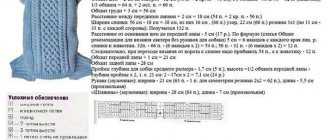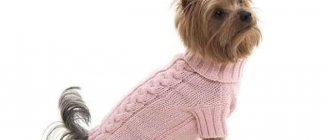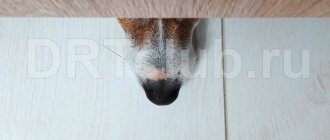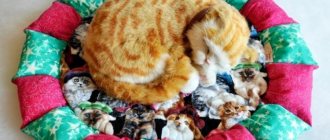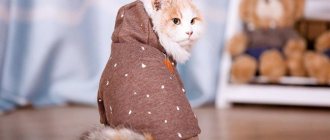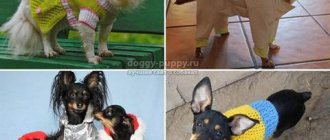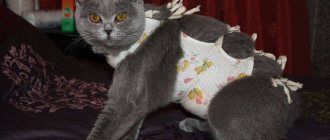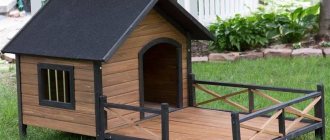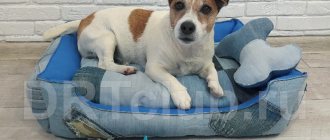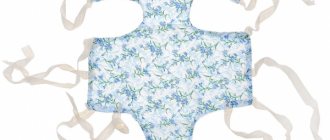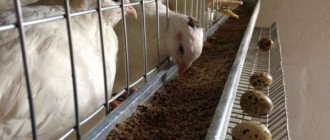Domestic dachshunds get cold in the cold season and need good warm clothes. Of course, stores selling pet supplies offer a large selection of equipment, and online stores offer a huge range of items for all occasions and seasons. But there are not always funds for this. Making clothes for a dachshund with your own hands is quite simple, you just need time and a little desire. Well, we’ll tell you how now.
How to take measurements
Sewing any product begins with a pattern, and the pattern is built according to the measurements taken. In order for the item to be sewn correctly, fit well on the dog and not interfere with it during a walk, you need to take the correct measurements.
The most important rule is that we take all measurements when the dog is in a “standing” position.
Need to measure:
- The neck circumference is where a dog usually wears a collar.
- Chest circumference is the widest part of the chest. The measurement is taken behind the front paws.
- The tummy circumference or “waist” is the thinnest part of the body. Measure in front of the hind legs.
- The volume of the front paw at its widest part.
- Distance from the neck (first measurement) to the front paws along the chest line.
- Distance from the neck to the beginning of the tail.
- The distance between the front paws along the chest (a centimeter parallel to the floor).
Based on the measurements taken, you can begin to build a pattern for the future update of your favorite dachshund. On a piece of paper we draw a line equal to the length of the back plus 8-10 cm. Then we draw a line down equal to half the volume of the chest plus 3-5 cm and build a rectangle. On this line we mark the distance from the neck to the front paws and set aside half of the distance between the front paws (our last measurement). This will be the slot for the paws. If you are confused, there are detailed diagrams below.
Attach the pattern to the dog and adjust it if you want the item to fit tighter. If it’s the other way around and the clothes should be looser, add a few more centimeters when transferring them to the fabric. Do not forget about seam allowances, at least 0.5-1 cm.
Fabric selection
The type of material for sewing dog clothes depends on the specific product:
- Bologna is suitable for a raincoat;
- For lining it is better to use plush, padding polyester, or fleece;
- polyester is a good option for overalls;
- 100% cotton is suitable for all other types of clothing.
- I'm a bee!..
Note. In order not to make a mistake with the amount of fabric, first you need to make a pattern of the model on paper. Another point: sewing clothes from a plain material is easier, since the fabric with a pattern needs to be adjusted to the pattern. For the same reason, you will need more multi-colored material (about 50 cm) than regular (one-color) material.
DIY dachshund blanket
The simplest and at the same time convenient, practical and functional thing for a dachshund is a blanket. Sewing it with your own hands is not at all difficult. This will require a minimum of time and consumables:
- a piece of fabric measuring approximately 75*75 cm;
- about 3 m of bias tape for edging the edges (you can cut it yourself, but it’s easier to buy ready-made);
- accessories for fastening - Velcro 25-30 cm or several buttons;
- pattern.
You can sew either on a sewing machine or by hand. The process itself is simple, but in the second case it will take a little longer.
Selection of materials
Spokes:
- On the line. Convenient to knit socks, blankets, booties.
- Simple. They knit sweaters, overalls, sweaters.
Hook:
For knitting casual clothes from bulky yarn, choose a thick hook. For an openwork elegant blanket, take a thin hook the thickness of a thin thread.
The yarn labels indicate what thickness the working tool (knitting needles, crochet hook) is suitable for.
Yarn:
- pure wool, thick wool blend - for every day.
- synthetic yarn (acrylic) for extravagant holiday items that are worn rarely and for a short time.
Natural wool allows the skin to breathe, but in synthetic clothes the dog will quickly freeze.
Transfer the pattern and sew the blanket
Fold the piece of fabric in half with the right sides facing in. Place the paper pattern so that the middle of the back is on the fold of the fabric (in this case, the back will be without a seam). You will get 1 back piece and 1 breast piece. From the remaining fabric, cut a rectangle about 11*17 cm - this is the collar for the blanket.
Sew the back to the chest, sew on the collar, and trim the free edges with bias tape. The seams can be finished with an edge stitch to prevent fraying. Sew Velcro or buttons onto the collar and sides of the blanket. New clothes for your dachshund's wardrobe are ready.
No sewing
Even if the owner of a dachshund does not know how to sew and knit, this is not a reason to leave her pet without fashionable clothes. To make an original outfit, children's clothing, an old sweater, and a sock are suitable.
To make warm clothes for a small dachshund, a terry sock or stocking will do just fine.
It is enough to mark the places for the puppy’s paws and tail on the unfolded toe, make holes and cut off the heel - and half the job is done. All that remains is to process the cuts and decorate the resulting sweater as desired.
The sleeve of a warm jumper will make a great outfit for a dachshund, which can be made in one to two hours. Cut off the sleeve, remove the excess based on the length of the dog and 7–10 cm, which will go to the collar. The algorithm of actions is simple - cut out holes for the paws, crochet them and you can dress up the dog. For the winter version, additionally sew on sleeves for the paws.
Knitted clothes for a little pet can be made from an old sweater, hat or even scarf.
If you first wash the sleeve in the washing machine at a hot temperature several times, it will shrink and resemble a felted item. A sweater made from such a sleeve is suitable even for severe frosts.
Since dachshunds are characterized by having a rather short coat, which is not able to protect the pet from the cold, clothing for them is not an ordinary luxury, but a necessary attribute of everyday life.
You can make a sweater from an old hat in a similar way - the main thing is that the product is long enough for a dachshund. Holes for the paws and head are cut out in the same way as before. To prevent the product from unraveling, the cuts are processed - and this is where the work on making an excellent vest ends. You can try on a new outfit for your dachshund.
DIY overalls for dachshunds
Sewing overalls for a dachshund is not difficult even for novice needlewomen. You just need to slightly adjust the existing pattern for the blanket:
- If necessary, extend the line of the back.
- Cut the back in two parts, since in overalls it is better to fasten at the top. Velcro or zipper are suitable for this purpose.
- Make the sleeves one-piece, modeling them directly on the pattern, or set-in, cutting them separately according to previously taken measurements. The length of the sleeve depends only on your preferences.
- Add 2-3 cm to the length of the sleeve so that you can make cuffs and insert an elastic band into them.
- Pay attention to the length of the chest - for a boy it ends just above the waist, for a girl you can extend it further so that almost the entire stomach is covered.
To begin, transfer the pattern onto a plain, thin fabric and baste it so that you can adjust it on your dog if necessary. For the final option, choose a durable and dense material, preferably waterproof, but not too rustling. Loud rustling of clothes can irritate the dog and cause discomfort, and walks will turn into torture.
You may be interested in - clothes and shoes for dogs: how to choose the right one or sew it yourself
Fashion ideas for different occasions
To meet all kinds of requirements and weather conditions, you can find many different examples of fashionable clothing. For example, if you live in a northern or mountainous area, your dog will most likely need at least one coat. Today, dog clothing looks like a coat with buttons, a shirt, trousers, dresses with rhinestones and funny straps, hats and bows.
Each person may have a sweater or shirt at home that he no longer needs. A little imagination and perseverance - and from this material you can independently sew beautiful exclusive clothes for your “youngest family member”. Knitting or sewing will help you with this. Beads, buttons, lace and bright fabrics are suitable for a special occasion. And then your dachshund will certainly not only be remembered, but also photographed by all the guests.
The dachshund fashion line has the following sizes:
- Miniature 11–12″, length 13–14.5″, girth – up to 6 months.
- Very small 12-13″, length 14-15.5″, girth – miniature.
- Average 15–16″, length 17–18.5″, girth – long miniature.
- Large 17-18″, length 19-21″, girth – standard.
- Emergency 19–20″, length 21–23″, girth – standard.
Winter clothes for dachshunds
Down jackets for dogs should be used in the coldest and wettest conditions. The jackets have a panel that covers the chest. They fit around the hips to cover the dog's paws and keep them warm. It should be remembered that a dachshund should have several outfits in his wardrobe for the winter season, because clothes quickly get dirty and need to be washed often.
Ideas for a dachshund: boy and girl
For a girl, the product can be decorated with:
- ruffles or bows,
- hat and scarf,
- hat with feather,
- guipure collar.
For a boy, jewelry from:
- top hat and butterfly,
- suspenders,
- tuxedo
You can always explore the Internet for new clothing ideas for dogs. Human imagination knows no bounds, perhaps you will come up with some unique thing that only your dachshund will flaunt. In addition, a handmade product is a source of pride not only for your pet, but also for you!
Knitted clothes for dachshunds
If you know how to handle knitting needles and balls of thread at least a little, try knitting clothes for your pet. Every knitter always has leftover yarn from previous projects. You will need about 200 grams of thread and knitting needles of suitable thickness. Knitting a sweater for a dachshund is a simple and quick activity:
- Always start from the neckline, knit the first 10-12 rows with an elastic band. If you want a collar with a turn-up, double the number of rows.
- If you want the sweater to fit tightly, decrease the loops from the middle of the fabric to the waist according to the dog’s measurements.
- The sleeves can be knitted on circular knitting needles, picking up stitches from the product, or knitted separately and sewn to the finished sweater.
Beginning knitters can get by with simple stocking stitch or stockinette stitch, decorating the finished item with buttons, appliques or a brooch. More experienced craftswomen will delight their pets with sweaters with braids, plaits and other original patterns.
When choosing threads, give preference to natural yarn or one that contains at least 40% natural wool or cotton fibers.
Knitting
The most common type of knitted clothing for dachshunds is a sweater.
Knitted sweater
To create an item you will need:
- Prepare knitting needles, yarn, zipper.
- Start knitting from the neckline. It can be of two types: with or without a lapel. With each new level the number of loops increases. This is necessary so that the dog’s chest is completely covered with fabric.
- Having tied the product to the front paws, they move to the back. The number of loops decreases as you approach the tail.
- Next, knit the holes for the paws, and then the bottom of the sweater. The bottom of the product is made with a simple elastic band (the same as the neck).
- The next stage is the sleeves. To do this, you need to knit 2 rectangles and connect them along the edges, creating cylinders. They are then sewn to the holes of the sweater.
- A fastener is attached to the free edges of the product.
Creating clothes for Dachshund dogs is not an easy task and requires certain skills. However, the time and effort spent more than pays off with an excellent result - because now the pet has its own unique clothes, thanks to which the dachshund will feel comfortable in any bad weather, and will also stand out from other dogs.
Knitting kit for a dog: jumper and helmet
When walking in windy weather, special attention should be paid to protecting your pet's ears and head. A hat and hood will help you cope with this task.
The helmet hat does not fall off the head and does not creep over the eyes; it covers not only the top of the head, but also the neck. The hood provides additional insulation. To knit a jumper and a hat-helmet for a small dog, you will need:
- 200 g yarn;
- straight and double needles No. 2.5.
Important! Knitting is done from top to bottom. Cast on 46 stitches on straight knitting needles and knit 2 rows in garter stitch
Then knit 20 rows with a 1×1 rib. Then they move to the front surface. In the first row, 3 loops retreat from the edge, in the second - 4 loops, in the third - 5 and so on, add 1 loop on both sides in each row 15 times. This makes a total of 28 rows from the elastic band.
Cast on 46 stitches on straight knitting needles and knit 2 rows in garter stitch. Then knit 20 rows with a 1×1 rib. Then they move to the front surface. In the first row, 3 loops retreat from the edge, in the second - 4 loops, in the third - 5 and so on, add 1 loop on both sides in each row 15 times. The total is 28 rows from the elastic band.
For armholes, 10 stitches in stockinette stitch (for the chest), 12 stitches are cast off (for the armhole), 32 loops in stitch stitch (for the back), 12 loops are cast off (for the second armhole), 10 loops in stitch stitch (for the chest) and knit a row separately on every part. Then knit through all the loops, restoring 12 loops of each armhole. In total, you should get 72 rows from the elastic band. At the end, knit 4 rows with an elastic band and close all the loops.
For the sleeves, cast on 28 stitches along the edge of the armholes on stocking needles and knit 18 rows in the round with a 1×1 elastic band, cast off all stitches.
To connect, the middle seam of the jumper is made, the collar is left unsewn.
For the helmet, cast on 86 stitches on straight needles and knit 12 rows in stockinette stitch. For ties, you need to close 14 loops at both ends in the 4th row from the beginning of knitting.
After completing the 12th row, you need to divide the fabric into 3 parts: 2 × 15 loops for the side parts and 28 loops for the top part. Next, knit 4 rows, decreasing 1 loop in every second row 14 times on both sides of the upper part of the fabric. Close all loops. A seam is made in the middle of the cap. Having laid a small fold, the hood is hemmed to the hat.
What might your mini dog need?
First of all , functional clothing. In rainy weather - a waterproof raincoat and boots, in the scorching sun - a light T-shirt or dress and a Panama hat, in winter - a warm soft sweater and a hat. These clothes are designed to increase the comfort of walking for your baby and protect his health from hypothermia, sunburn, scratches and dirt, because daily washing is not always good for sensitive dog skin.
Secondly , home clothes. These can be either hygienic panties for girls during heat or soft pajamas, in which your pet will not only look very cute, but will also not freeze, even if there are drafts on the floor.
Third , carnival clothes, in case you decide to take your toy out into the world or just show off to your friends. Here everything is limited only by your imagination, it can be fluffy dresses with frills, office suits with a tie, and any other wardrobe items taken from human clothing and adapted to suit your four-legged friend.
If you can do without carnival and home clothes, then street clothes necessary in our climate . The main thing to remember is that the clothes should be comfortable for your pet.
Important! It is better to choose natural fabric, because synthetics often cause allergic reactions even in humans.
Things should be neither small nor great.
Recommendations for craftswomen
- Ideas for making a blanket, vest or overalls for a pet are searched on the Internet, on specialized sites dedicated to dog breeding, as well as on resources for needlewomen. By using your imagination, you can get an outfit with a twist that no one else has.
- Making your own wardrobe for a dog will allow you to make it extensive, for any weather and without extra costs.
- If you don’t have time, you can use a simple method to insulate your friend. A sleeve is cut off from an unnecessary children's woolen jacket, in which holes are cut for the paws. If you overcast the edges, the item will look finished.
Make it yourself or buy it in a store?
Dog fashion is quite common today. Moreover, bespoke tailoring and ready-made models sold in pet stores are equally popular. Needlewomen happily dress their pets in sewn suits, hats, raincoats and other clothes. Everyone else is actively purchasing stylish models of the same clothes in stores.
Sorry, there are no surveys available at this time.
Both options have their pros and cons. If you decide to sew something with your own hands, you can do it exactly as you see fit in exact accordance with the size of your pet. And besides, it turns out to be much cheaper than buying clothes for dogs in the store.
But, on the other hand, you are unlikely to be able to sew or knit fashionable items, luxurious collars, intricate caps, raincoats and pants with your own hands. Therefore, if you really want to please your dog with a fashionable suit, then if you have the means, you can afford it for yourself and for him. Moreover, clothes for dachshunds are not uncommon in pet stores. Well, if you have the desire and minimal skills in needlework, you can significantly increase the size of your pet’s wardrobe.
Patterning Lesson: Basic Pattern for Dogs
Now we will talk about our smaller brothers - dogs and clothes for them. None of the dog lovers will argue that clothing for them in the city has become simply necessary. After all, our pets are no longer the same descendants of wolves, they are accustomed to the warmth and dryness of apartments, and besides, these reagents are used to treat roads from ice... Today I suggest you create a pattern for the basis of overalls for a dog according to the pet’s individual sizes, with the ability to subsequently model this basis and create various models and cuts.
